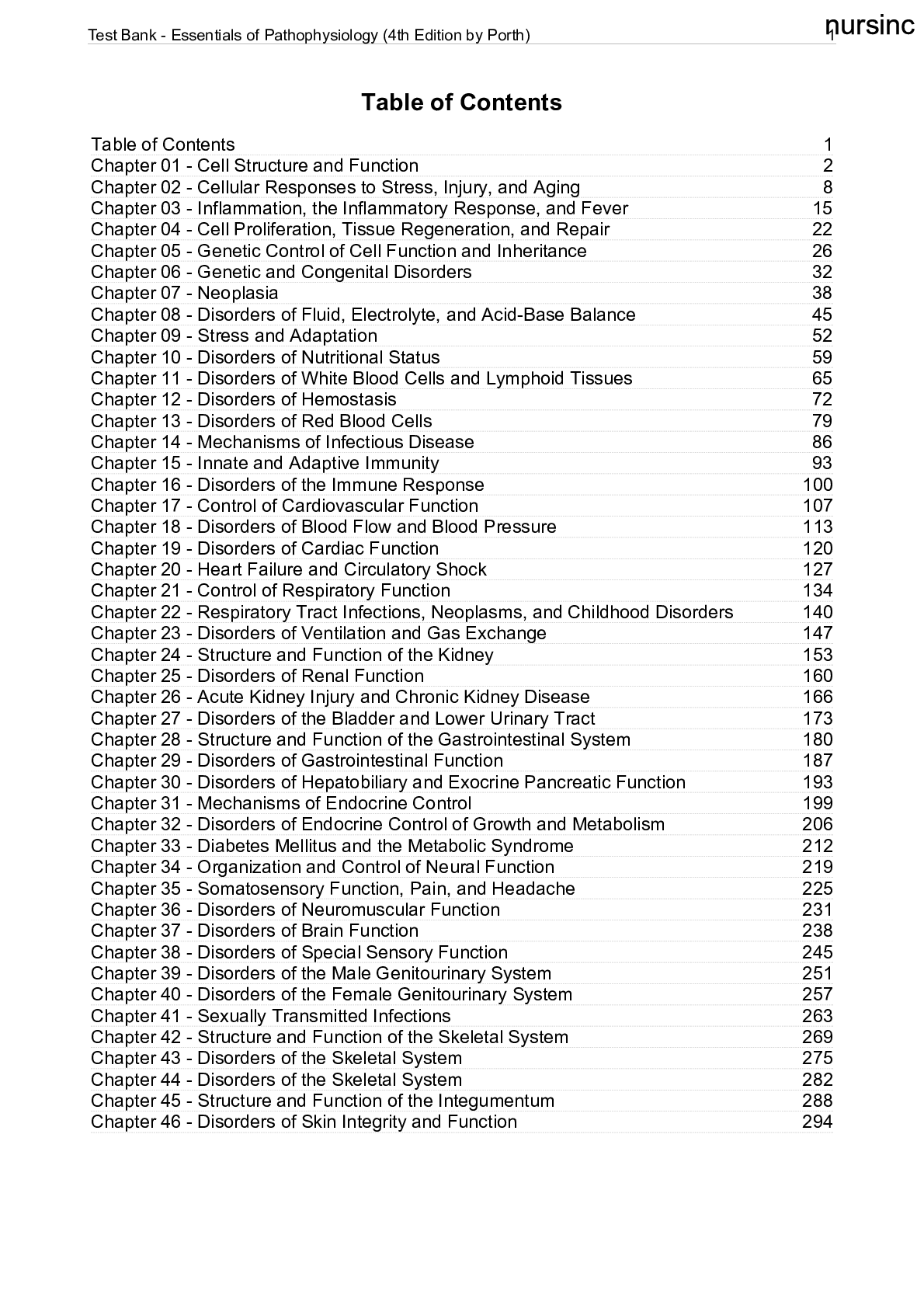*NURSING > TEST BANKS > WALDEN UNIVERSITY. TestBank-Porth-of-Patho Edition 3.pdf. 99% PROVEN PASS RATE. GRADED A+ (All)
WALDEN UNIVERSITY. TestBank-Porth-of-Patho Edition 3.pdf. 99% PROVEN PASS RATE. GRADED A+
Document Content and Description Below
Chapter 02 - Cellular Responses to Stress, Injury, and Aging 1. Ischemia and other toxic injuries increase the accumulation of intracellular calcium as a result of: A) release of stored calcium from... the mitochondria. B) improved intracellular volume regulation. C) decreased influx across the cell membrane. D) attraction of calcium to fatty infiltrates. 2. The patient is found to have liver disease, resulting in the removal of a lobe of his liver. Adaptation to the reduced size of the liver leads to ___________ of the remaining liver cells. A) metaplasia B) organ atrophy C) compensatory hyperplasia D) physiologic hypertrophy 3. A person eating peanuts starts choking and collapses. His airway obstruction is partially cleared, but he remains hypoxic until he reaches the hospital. The prolonged cell hypoxia caused a cerebral infarction and resulting __________ in the brain. A) caspase activation B) coagulation necrosis C) rapid phagocytosis D) protein p53 deficiency 4. Bacteria and viruses cause cell damage by _______, which is unique from the intracellular damage caused by other injurious agents. A) disrupting the sodium/potassium ATPase pump B) interrupting oxidative metabolism processes Test Bank - Essentials of Pathophysiology (4th Edition by Porth) 8 C) replicating and producing continued injury D) decreasing protein synthesis and function 5. The patient has a prolonged interruption in arterial blood flow to his left kidney, causing hypoxic cell injury and the release of free radicals. Free radicals damage cells by: A) destroying phospholipids in the cell membrane. B) altering the immune response of the cell. C) disrupting calcium storage in the cell. D) inactivation of enzymes and mitochondria. 6. Injured cells have impaired flow of substances through the cell membrane as a result of: A) increased fat load. B) altered permeability. C) altered glucose utilization. D) increased surface receptors. 7. Reversible adaptive intracellular responses are initiated by: A) stimulus overload. B) genetic mutations. C) chemical messengers. D) mitochondrial DNA. 8. Injured cells become very swollen as a result of: A) increased cell protein synthesis. B) altered cell volume regulation. C) passive entry of potassium into the cell. Test Bank - Essentials of Pathophysiology (4th Edition by Porth) 9 D) bleb formation in the plasma membrane. 9. A diabetic patient has impaired sensation, circulation, and oxygenation of his feet. He steps on a piece of glass, the wound does not heal, and the area tissue becomes necrotic. The necrotic cell death is characterized by: A) rapid apoptosis. B) cellular rupture. C) shrinkage and collapse. D) chronic inflammation. 10. A 99-year-old woman has experienced the decline of cell function associated with age. A group of theories of cellular aging focus on programmed: A) changes with genetic influences. B) elimination of cell receptor sites. C) insufficient telomerase enzyme. D) DNA mutation or faulty repair. 11. An 89-year-old female patient has experienced significant decreases in her mobility and stamina during a 3-week hospital stay for the treatment of a femoral head fracture. Which of the following phenomena most likely accounts for the patient’s decrease in muscle function that underlies her reduced mobility? A) Impaired muscle cell metabolism resulting from metaplasia B) Dysplasia as a consequence of inflammation during bone remodeling C) Disuse atrophy of muscle cells during a prolonged period of immobility D) Ischemic atrophy resulting from vascular changes while on bedrest 12. A 20-year-old college student has presented to her campus medical clinic for a scheduled Papanicolaou (Pap) smear. The clinician who will interpret the smear will examine cell samples for evidence of: A) changes in cell shape, size, and organization. B) the presence of unexpected cell types. Test Bank - Essentials of Pathophysiology (4th Edition by Porth) 10 C) ischemic changes in cell samples. D) abnormally high numbers of cells in a specified field. 13. Which of the following pathophysiologic processes is most likely to result in metastatic calcification? A) Benign prostatic hyperplasia B) Liver cirrhosis C) Impaired glycogen metabolism D) Hyperparathyroidism 14. Despite the low levels of radiation used in contemporary radiologic imaging, a radiology technician is aware of the need to minimize her exposure to ionizing radiation. What is the primary rationale for the technician’s precautions? A) Radiation stimulates pathologic cell hypertrophy and hyperplasia. B) Radiation results in the accumulation of endogenous waste products in the cytoplasm. C) Radiation interferes with DNA synthesis and mitosis. D) Radiation decreases the action potential of rapidly dividing cells. 15. The parents of a 4-year-old girl have sought care because their daughter has admitted to chewing and swallowing imported toy figurines that have been determined to be made of lead. Which of the following blood tests should the care team prioritize? A) White blood cell levels with differential B) Red blood cell levels and morphology C) Urea and creatinine levels D) Liver function panel 16. A 70-year-old male patient has been admitted to a hospital for the treatment of a recent hemorrhagic stroke that has left him with numerous motor and sensory deficits. These deficits are most likely the result of which of the following mechanisms of cell injury? A) Free radical injury Test Bank - Essentials of Pathophysiology (4th Edition by Porth) 11 B) Hypoxia and ATP depletion C) Interference with DNA synthesis D) Impaired calcium homeostasis 17. Which of the following processes associated with cellular injury is most likely to be reversible? A) Cell damage resulting from accumulation of fat in the cytoplasm B) Cellular changes as a result of ionizing radiation C) Cell damage from accumulation of free radicals D) Apoptosis 18. The extrinsic pathway of apoptosis can be initiated by: A) damage to cellular DNA. B) decreased ATP levels. C) activation of the p53 protein. D) activation of death receptors on the cell surface. 19. A patient with severe peripheral vascular disease has developed signs of dry gangrene on the great toe of one foot. Which of the following pathophysiologic processes most likely contributed to this diagnosis? A) Inappropriate activation of apoptosis B) Bacterial invasion C) Impaired arterial blood supply D) Metaplastic cellular changes 20. Which of the following facts underlies the concept of replicative senescence? A) Genes controlling longevity are present or absent in varying quantities among different individuals. B) Telomeres become progressively shorter in successive generations of a cell. Test Bank - Essentials of Pathophysiology (4th Edition by Porth) 12 C) The damaging influence of free radicals increases exponentially in later generations of a cell. D) Aging produces mutations in DNA and deficits in DNA repair. Answer Key 1. A 2. C 3. B 4. C 5. A 6. B 7. C 8. B 9. B 10. A 11. C 12. A 13. D 14. C 15. B 16. B 17. A 18. D 19. C Test Bank - Essentials of Pathophysiology (4th Edition by Porth) 13 20. B Test Bank - Essentials of Pathophysiology (4th Edition by Porth) 14 Chapter 03 - Inflammation, the Inflammatory Response, and Fever 1. The characteristic, localized cardinal signs of acute inflammation include: A) fever. B) fatigue. C) redness. D) granuloma. 2. The vascular, hemodynamic stage of acute inflammation is initiated by momentary vasoconstriction followed by vasodilation that causes localized: A) bleeding. B) congestion. C) pale skin. D) coolness. 3. The cellular stage of acute inflammation is marked by the movement of leukocytes into the area. Which of the following cells arrives early in great numbers? A) Basophils B) Lymphocytes C) Neutrophils D) Platelets 4. The phagocytosis process involves three distinct steps. What is the initial step in the process? A) Engulfment B) Intracellular killing C) Antigen margination Test Bank - Essentials of Pathophysiology (4th Edition by Porth) 15 D) Recognition and adherence 5. Which of the following mediators of inflammation causes increased capillary permeability and pain? A) Serotonin B) Histamine C) Bradykinin D) Nitric oxide 6. Inflammatory exudates are a combination of several types. Which of the following exudates is composed of enmeshed necrotic cells? A) Serous B) Fibrinous C) Suppurative D) Membranous 7. The acute-phase systemic response usually begins within hours of the onset of inflammation and includes: A) fever and lethargy. B) decreased C-reactive protein. C) positive nitrogen balance. D) low erythrocyte sedimentation rate. 8. In contrast to acute inflammation, chronic inflammation is characterized by which of the following phenomena? A) Profuse fibrinous exudation B) A shift to the left of granulocytes C) Metabolic and respiratory alkalosis D) Lymphocytosis and activated macrophages Test Bank - Essentials of Pathophysiology (4th Edition by Porth) 16 9. Exogenous pyrogens (interleukin-1) and the presence of bacteria in the blood lead to the release of endogenous pyrogens that: A) stabilize thermal control in the brain. B) produce leukocytosis and anorexia. C) block viral replication in cells. D) inhibit prostaglandin release. 10. An older adult patient has just sheared the skin on her elbow while attempted to boost herself up in bed, an event that has precipitated acute inflammation in the region surrounding the wound. Which of the following events will occur during the vascular stage of the patient’s inflammation? A) Outpouring of exudate into interstitial spaces B) Chemotaxis C) Accumulation of leukocytes along the epithelium D) Phagocytosis of cellular debris 11. Which of the following individuals most likely has the highest risk of experiencing chronic inflammation? A) A patient who has recently been diagnosed with type 2 diabetes B) A patient who is a carrier of an antibiotic-resistant organism C) A patient who is taking oral antibiotics for an upper respiratory infection D) A patient who is morbidly obese and who has a sedentary lifestyle 12. Which of the following core body temperatures is within normal range? A) 35.9°C (96.6°F) B) 38.0°C (100.4°F) C) 35.5°C (95.9°F) D) 37.3°C (99.1°F) Test Bank - Essentials of Pathophysiology (4th Edition by Porth) 17 13. A postsurgical patient who is recovering in the postanesthetic recovery unit states that she is freezing cold. Which of the following measures is likely to be initiated in the patient’s hypothalamus in an effort to reduce heat loss? A) Opening of arteriovenous (AV) shunts B) Reduced exhalation of warmed air C) Contraction of pilomotor muscles D) Decreased urine production 14. An elderly patient is dressed only in a hospital gown and complains of a draft in her room. Consequently, she has requested a warm blanket while she sits in her wheelchair. Which of the following mechanisms of heat loss is most likely the primary cause of her request? A) Evaporation and conduction B) Radiation and convection C) Conduction and convection D) Convection and evaporation 15. Which of the following pathophysiologic processes are capable of inducing the production of pyrogens? Select all that apply. A) Acute inflammation B) Obesity C) Myocardial infarction D) Malignancy E) Renal failure 16. Which of the following patients is most likely to be susceptible to developing a neurogenic fever? A) A patient who has stage II Alzheimer disease B) A patient who has sustained a head injury in a bicycle crash Test Bank - Essentials of Pathophysiology (4th Edition by Porth) 18 C) A patient who has become delirious after the administration of a benzodiazepine D) A patient who has begun taking a selective serotonin-reuptake inhibitor (SSRI) for the treatment of depression 17. Patients are commonly administered antipyretics when their oral temperature exceeds 37.5°C (99.5°F). Which of the following statements related to the rationale for this action is most accurate? A) Temperatures in excess of 37.5°C (99.5°F) can result in seizure activity. B) Lower temperatures inhibit the protein synthesis of bacteria. C) There is little empirical evidence for this treatment modality. D) Most common antipyretics have been shown to have little effect on core temperature. 18. A patient has sought care because of recent malaise and high fever. Upon assessment, the patient states that his current fever began two days earlier, although he states that for the last 2 weeks he is in a cycle of high fever for a couple of days followed by a day or two of normal temperature. Which of the following fever patterns is this patient experiencing? A) Recurrent fever B) Remittent fever C) Sustained fever D) Intermittent fever 19. A febrile, 3-week-old infant has been brought to the emergency department by his parents and is currently undergoing a diagnostic workup to determine the cause of his fever. Which of the following statements best conveys the rationale for this careful examination? A) The immature hypothalamus is unable to perform normal thermoregulation. B) Infants are susceptible to serious infections because of their decreased immune function. C) Commonly used antipyretics often have no effect on the core temperature of infants. D) Fever in neonates is often evidence of a congenital disorder rather than an infection. 20. An 84-year-old patient’s blood cultures have come back positive, despite the fact that his oral temperature has remained within normal range. Which of the following phenomena underlies the alterations in fever response that occur in the elderly? Test Bank - Essentials of Pathophysiology (4th Edition by Porth) 19 A) Disturbance in the functioning of the th [Show More]
Last updated: 2 years ago
Preview 1 out of 301 pages

Buy this document to get the full access instantly
Instant Download Access after purchase
Buy NowInstant download
We Accept:

Reviews( 0 )
$15.00
Can't find what you want? Try our AI powered Search
Document information
Connected school, study & course
About the document
Uploaded On
Mar 20, 2022
Number of pages
301
Written in
Additional information
This document has been written for:
Uploaded
Mar 20, 2022
Downloads
0
Views
140



.png)

.png)
.png)


.png)





